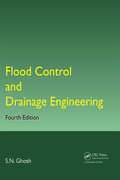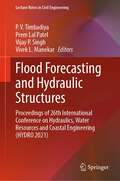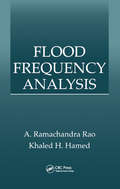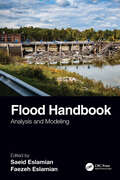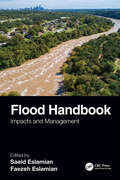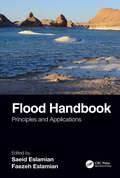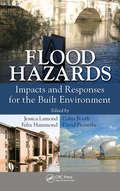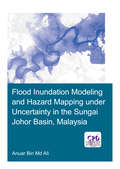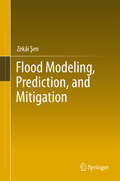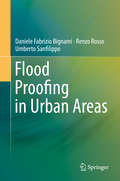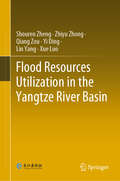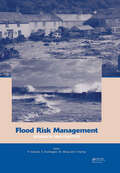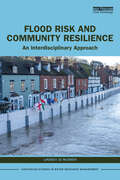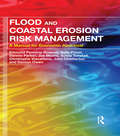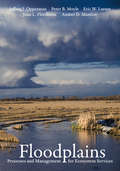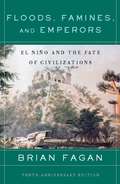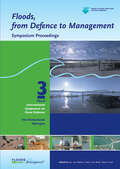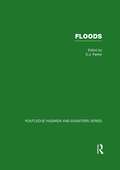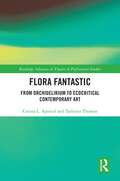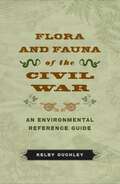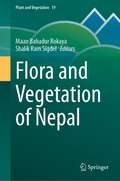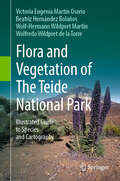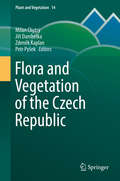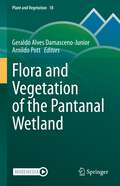- Table View
- List View
Flood Control and Drainage Engineering
by S.N. GhoshPrimarily written as course material on flood control and drainage engineering for advanced students of civil engineering, this new fourth edition is again thoroughly revised. It accommodates recent developments in remote sensing, information technology and GIS technology. New added material deals with flood management due to Tsunami waves, floodin
Flood Forecasting and Hydraulic Structures: Proceedings of 26th International Conference on Hydraulics, Water Resources and Coastal Engineering (HYDRO 2021) (Lecture Notes in Civil Engineering #340)
by Vijay P. Singh P. V. Timbadiya Prem Lal Patel Vivek L. ManekarThis book comprises the proceedings of the 26th International Conference on Hydraulics, Water Resources and Coastal Engineering (HYDRO 2021) focusing on broad spectrum of emerging opportunities and challenges in the field of flood forecasting and hydraulic structures. It covers a range of topics, including, but not limited to, early warning system, urban flood modelling and management, dam hazard classification, river training and protection works, structural and non-structural measures for flood mitigation, assessment and development of flood vulnerability, hazard and risk maps rehabilitation of old dams, streamflow turbines, canal operation and related structure, operation and management of dams including their instrumentation etc.Presenting recent advances in the form of illustrations, tables, and text, it offers readers insights for their own research. In addition, the book addresses fundamental concepts and studies in the field of flood forecasting and hydraulic structures, making it a valuable resource for both beginners and researchers wanting to further their understanding of hydraulics, water resources and coastal engineering.
Flood Frequency Analysis
by A. Ramachandra Rao Khaled H. HamedAfter five decades, the field of Statistical Hydrology continues to evolve and remains a very active area of investigation. Researchers continue to examine various distributions, methods of estimation of parameters, and problems related to regionalization. However, much of this research appears in journals and reports and usually in a form not easi
Flood Handbook: Analysis and Modeling
by Saeid Eslamian and Faezeh EslamianFloods are difficult to prevent but can be managed in order to reduce their environmental, social, cultural, and economic impacts. Flooding poses a serious threat to life and property, and therefore it’s very important that flood risks be taken into account during any planning process. This handbook presents different aspects of flooding in the context of a changing climate and across various geographical locations. Written by experts from around the world, it examines flooding in various climates and landscapes, taking into account environmental, ecological, hydrological, and geomorphic factors, and considers urban, agricultural, rangeland, forest, coastal, and desert areas. Features: Presents the main principles and applications of the science of floods, including engineering and technology, natural science, and sociological implications. Considers floods in urban, agricultural, rangeland, forest, coastal, and desert areas. Covers flood control structures as well as preparedness and response methods. Written in a global context, by contributors from around the world.
Flood Handbook: Impacts and Management
by Saeid Eslamian and Faezeh EslamianFloods are difficult to prevent but can be managed in order to reduce their environmental, social, cultural, and economic impacts. Flooding poses a serious threat to life and property, and therefore it’s very important that flood risks be taken into account during any planning process. This handbook presents different aspects of flooding in the context of a changing climate and across various geographical locations. Written by experts from around the world, it examines flooding in various climates and landscapes, taking into account environmental, ecological, hydrological, and geomorphic factors, and considers urban, agriculture, rangeland, forest, coastal, and desert areas. Features Presents the main principles and applications of the science of floods, including engineering and technology, natural science, as well as sociological implications. Examines flooding in various climates and diverse landscapes, taking into account environmental, ecological, hydrological, and geomorphic factors. Considers floods in urban, agriculture, rangeland, forest, coastal, and desert areas Covers flood control structures as well as preparedness and response methods. Written in a global context, by contributors from around the world.
Flood Handbook: Principles and Applications
by Saeid Eslamian and Faezeh EslamianFloods are difficult to prevent but can be managed in order to reduce their environmental, social, cultural, and economic impacts. Flooding poses a serious threat to life and property, and therefore it’s very important that flood risks be taken into account during any planning process. This handbook presents different aspects of flooding in the context of a changing climate and across various geographical locations. Written by experts from around the world, it examines flooding in various climates and landscapes, taking into account environmental, ecological, hydrological, and geomorphic factors, and considers urban, agriculture, rangeland, forest, coastal, and desert areas. Features Presents the main principles and applications of the science of floods, including engineering and technology, natural science, as well as sociological implications. Examines flooding in various climates and diverse landscapes, taking into account environmental, ecological, hydrological, and geomorphic factors. Considers floods in urban, agriculture, rangeland, forest, coastal, and desert areas Covers flood control structures as well as preparedness and response methods. Written in a global context, by contributors from around the world.
Flood Hazards: Impacts and Responses for the Built Environment
by Jessica Lamond David Proverbs Colin Booth Felix HammondA 360-degree view of the response to flood riskAs major flooding events around the world show, the impact of flooding on the built environment can cause widespread chaos. These flood events form part of a wider pattern of increasing flood frequency coupled with increased vulnerability of the built environment to flood hazard. Flood risk can unite o
Flood Inundation Modeling and Hazard Mapping under Uncertainty in the Sungai Johor Basin, Malaysia (IHE Delft PhD Thesis Series)
by Anuar Bin AliFlooding can have devastating impacts on people’s livelihood, economy and the environment. An important instrument in flood management is floodplain maps, which assist land planners and local authorities in identifying flood-prone areas, and provide useful information for rescue and relief agencies for their operations. Developing floodplain maps often involves flood inundation modeling. This typically requires precipitation and stream flow data, topographic information, building a hydraulic model and calibration of its parameters. Often however, floodplain maps are built on a single model outcome without an explicit consideration of all the sources of uncertainty in the modeling process. The research presented in this thesis addresses the uncertainty in flood inundation modeling, which may arise from input data and hydraulic modeling approach. The study area is the Sungai Johor basin in Johor, Malaysia, an agriculture-dominated area. The present study analyses the modelling uncertainties arising from estimations of design flow, terrain data sets, geometric description in hydraulic models and different modeling approaches, and develops recommendations for practitioners. Explicit account for uncertainties and studying their impact in flood inundation mapping allow for more informed and effective decision making.
Flood Modeling, Prediction and Mitigation
by Zekâi ŞenThis book draws on the author’s professional experience and expertise in humid and arid regions to familiarize readers with the basic scientific philosophy and methods regarding floods and their impacts on human life and property. The basis of each model, algorithm and calculation methodology is presented, together with logical and analytical strategies. Global warming and climate change trends are addressed, while flood risk assessments, vulnerability, preventive and mitigation procedures are explained systematically, helping readers apply them in a rational and effective manner. Lastly, real-world project applications are highlighted in each section, ensuring readers grasp not only the theoretical aspects but also their concrete implementation.
Flood Proofing in Urban Areas
by Daniele Fabrizio Bignami Renzo Rosso Umberto SanfilippoFlood control in urban areas can be feasibly and cost-effectively enhanced by implementing flood proofing approaches to risk reduction in the context of environmental and land-use planning and management. Indeed, flood proofing makes it possible to improve, integrate and in some cases even replace traditional measures for flood control, reducing the vulnerability and increasing the resilience of buildings and infrastructures.This book begins by reviewing the physics of stability and instability of both human beings and buildings under flood conditions, together with criteria and models (both conventional and innovative) for assessing flood strains. In turn, it presents a range of flood proofing concepts and techniques, together with a complete and updated classification of related methods and devices. This provides a user-friendly tool to help identify appropriate solutions to real-world problems for each specific risk scenario.In particular, the book focuses on temporary flood proofing techniques, given their ability to deliver effective performance at low costs. Lastly, it features an overview of norms, guidelines and laboratory recommendations that are currently being adopted in various countries with regard to flood proofing devices and testing procedures.The purpose of this book is essentially to encourage authorities, stakeholders, technicians and end users to successfully develop flood proofing solutions that can reduce flood risk in a pragmatic manner. In addition, the authors hope to inspire researchers, manufacturers and designers (engineers, architects, urban planners and urban managers) to pursue further advances in this key sector of public and private safety in urban areas.
Flood Resources Utilization in the Yangtze River Basin
by Yi Ding Lin Yang Shouren Zheng Zhiyu Zhong Qiang Zou Xue LuoThis book is highly informative and carefully presented, providing scientific insights into the flood resources utilization in the Yangtze River Basin both for scholars and decision-makers. The book is for the purpose of analyzing the potential utilization of flood resources in the Yangtze River Basin and exploring effective ways to put forward the countermeasures against the risks. Major objectives of this book include: (1) revealing the characteristics of the inflow and the sediment variation in the upper reaches of the Yangtze River, quantitatively evaluating the potential utilization of the flood resources in the Yangtze River and demonstrating the feasibility of its utilization in the Basin; (2) proposing the necessity and feasibility of utilizing the flood resources by the Three Gorges Project; (3) shedding new light on the characteristics of the flood resources, presenting different methods of flood resources utilization in different regions over the Basin and raising the overall risk-optimized strategies of the flood resources utilization in the Yangtze River; (4) analyzing the risk of flood resources utilization for the Three Gorges Project regarding flood control, sediment, ecology, etc., and putting forward the risk-optimized countermeasures of flood resources utilization for the Three Gorges Project.
Flood Risk Management: Extended Abstracts Volume (332 pages) + full paper CD-ROM (1772 pages)
by Paul Samuels Stephen Huntington William Allsop Jackie HarropFloods cause distress and damage wherever and whenever they happen. Flooding from rivers, estuaries and the sea threatens many millions of people worldwide and economic and insurance losses from flooding have increased significantly since 1990. Based on the work of leading researchers, this book provides an overview of advances in this important subject. It covers all aspects of flood risk including the causes of floods; their impacts on people, property and the environment; and portfolios of risk management measurement. Additional topics include climate change, estimation of extremes, flash floods, flood forecasting and warning, inundation modeling, systems analysis, uncertainty, international programs, and flood defense infrastructure and assets. The book also examines environmental, human, and social impacts; vulnerability and resilience; risk sharing; and civil contingency planning and emergency management.
Flood Risk and Community Resilience: An Interdisciplinary Approach (Earthscan Studies in Water Resource Management)
by Lindsey Jo McEwenThis book details the impact of flooding on our environment, and the ways in which communities, and those that work with them, can act to manage the associated risks.Flooding is an increasingly significant environmental hazard which inflicts major costs to the economies and livelihoods of developed countries. This book explores how local communities can identify, manage, and adapt to the ever-increasing damage flooding causes. Focusing on the future role of local communities, the benefits and challenges of their involvement, and the potential areas of transformation, this book provides insights into the efficacy of interdisciplinary and transdisciplinary working. Alongside research into similar environmental hazards, this book also draws upon the author’s own knowledge of flood risk management in distinctive non-contiguous interdisciplinary settings. The chapters draw together a different and distinctive set of interdisciplinary themes in flood risk management and social resilience. In doing so, it strives to communicate the different ways of thinking that can usefully contribute to flood risk management.This book would be ideal for those researching flood risk management, alongside scholars and non-scholars alike who are interested in finding ways of adapting to environmental hazards working with local communities.
Flood and Coastal Erosion Risk Management: A Manual for Economic Appraisal
by Edmund Penning-Rowsell Sally Priest Dennis Parker Joe Morris Sylvia Tunstall Christophe Viavattene John Chatterton Damon OwenA new ‘Multi-Coloured Manual' This book is a successor to and replacement for the highly respected manual and handbook on the benefits of flood and coastal risk management, produced by the Flood Hazard Research Centre at Middlesex University, UK, with support from Defra and the Environment Agency. It builds upon a previous book known as the "multi-coloured manual" (2005), which itself was a synthesis of the blue (1977), red (1987) and yellow manuals (1992). As such it expands and updates this work, to provide a manual of assessment techniques of flood risk management benefits, indirect benefits, and coastal erosion risk management benefits. It has three key aims. First it provides methods and data which can be used for the practical assessment of schemes and policies. Secondly it describes new research to update the data and improve techniques. Thirdly it explains the limitations and complications of Benefit-Cost Analysis, to guide decision-making on investment in river and coastal risk management schemes.
Floodplains: Processes and Management for Ecosystem Services
by Peter B. Moyle Amber D. Manfree Jeffrey J. Opperman Eric W. Larsen Joan L. FlorsheimFloodplains provides an overview of floodplains and their management in temperate regions. It synthesizes decades of research on floodplain ecosystems, explaining hydrologic, geomorphic, and ecological processes and how under appropriate management these processes can provide benefits to society ranging from healthy fish populations to flood-risk reduction. Drawing on the framework of reconciliation ecology, the authors explore how new concepts for floodplain ecosystem restoration and management can increase these benefits. Additionally, they use case studies from California’s Central Valley and other temperate regions to show how innovative management approaches are reshaping rivers and floodplains around the world.
Floods, Famines, and Emperors: El Nino and the Fate of Civilizations
by Brian M. FaganIn 1999, few people had thought to examine the effects of climate on civilization. Now, due in part to the groundbreaking work of archaeologist Brian Fagan, climate change is a central issue. Revised and updated ten years after its first publication, Floods, Famines and Emperors remains the definitive account of how the world's best-known climate event had an indelible impact on history.
Floods, from Defence to Management: Symposium Proceedings of the 3rd International Symposium on Flood Defence, Nijmegen, The Netherlands, 25-27 May 2005, Book + CD-ROM
by Eelco Van Beek Jos Van Alphen Marco TaalFloods are natural events, but when they impact on human environments, they turn into disasters which disrupt society. The last decades have seen an alarming increase in the number of major floods and associated damage on every continent. The impact is more severe due to population growth and settlement in flood prone areas, climate change and disr
Floods: British Policies For Hazard Reduction, Agricultural Improvement And Wetland Conservation (Routledge Library Editions: Conservation Ser. #5)
by D. J. ParkerFloods occur in most parts of the world and range from being welcomed annual occurrences, to natural disasters which have countless physical and societal impacts. Floods presents the most comprehensive collection to date of new research, providing a rich body of theory and experience and drawing together contributions from over fifty leading international researchers in the field. An extensive range of case-studies covering major floods and regions prone to flooding worldwide are included.
Flora Fantastic: From Orchidelirium to Ecocritical Contemporary Art (ISSN)
by Corina L. Apostol Tashima ThomasThis book delves deep into colonial botany, utilizing mediums such as historical investigation, cinema, photography, live performance, and installation art.Surveying perspectives from Europe, the U.S., Africa, Southeast Asia, Latin America, and the Caribbean, it positions plants—both native and foreign—as active participants and silent observers in colonial narratives. By viewing through the prism of visual and performance art, this book touches on diverse topics like the economic value of plants, traditional and Western medicine, state‑endorsed scientific endeavors, migration patterns of flora and people, bio‑contact areas, nationalistic views, and botanical diplomacy. It offers fresh insights into colonial botany’s multifaceted history, emphasizing the intricate interplay between Eastern, Western, and Southern nations during the twentieth century and its enduring impact today.Serving as an invaluable addition to the realms of art history, performance studies, botany, visual culture, decolonial initiatives, and environmental politics, this book arrives at a pivotal moment when its insights are most crucial.
Flora and Fauna of the Civil War: An Environmental Reference Guide
by Kelby OuchleyDuring the Civil War, humans impacted plants and animals on an unprecedented scale as soldiers on both sides waged the most environmentally destructive war ever on American soil. Refugees and armies alike tramped across the landscape foraging for food, shelter, and fuel. Wild plants and animals formed barriers for armies and carried disease, yet also provided medicine and raw materials necessary to implement war, greatly influencing the day-to-day life of soldiers and civilians. Of the thousands of books written about the Civil War, few mention the environment, and none address the topic as a principal theme. In Flora and Fauna of the Civil War, Kelby Ouchley blends traditional and natural history to create a unique text that explores both the impact of the Civil War on the surrounding environment and the reciprocal influence of plants and animals on the war effort. The war generated an abundance of letters, diaries, and journals in which soldiers and civilians penned descriptions of plants and animals, sometimes as a brief comment in passing and other times as part of a noteworthy event in their lives. Ouchley collects and organizes these first-person accounts of the Civil War environment, adding expert analysis and commentary in order to offer an array of fascinating insights on the natural history of the era. After discussing the physical setting of the war and exploring humans' attitudes toward nature during the Civil War period, Ouchley presents the flora and fauna by individual species or closely related group in the words of the participants themselves. From ash trees to willows, from alligators to white-tailed deer, the excerpts provide glimpses of personal encounters with the natural world during the war, revealing how soldiers and civilians thought about and interacted with wild flora and fauna in a time of epic historical events. Collectively, no better sources exist to reveal human attitudes toward the environment in the Civil War era. This one-of-a-kind reference book will spark widespread interest among Civil War scholars, writers, and enthusiasts, as well as environmental historians.
Flora and Vegetation of Nepal (Plant and Vegetation #19)
by Maan Bahadur Rokaya Shalik Ram SigdelThis volume highlights the plant life of Nepal, which accounts for 20% of the Himalayan biodiversity. For the first time, this group of authors compile over 200 years’ worth of local botanical research. Due to the high topographical diversity, Nepal has a very unique flora and vegetation. The chapters focus on cryptogams, phanerogams and alien flora. As an added bonus, historical background for native and invasive species, is explained. Aside from botanical knowledge, the authors also shed a light on Nepali geography, soil, climate and land use. To complete the picture, readers will find data on different plants, maps and photographs of unique species. This book is a valuable resource for Botanists and Ecologists, but also for interested travelers who would like to complement their next trek in Nepal.
Flora and Vegetation of The Teide National Park: Illustrated Guide to Species and Cartography
by Victoria Eugenia Martín Osorio Beatriz Hernández Bolaños Wolf-Hermann Wildpret Martín Wolfredo Wildpret de la TorreThis book presents a detailed map of the Vegetation Series and Bioclimatic Belts that shape the high volcanic landscape of Tenerife. El Teide, part of the National Park of the same name, was designated a UNESCO World Heritage Site on June 28, 2007. It is also a protected natural monument, encompassing the Teide-Pico Viejo volcanic complex, a large Vesuvian-type stratovolcano that has remained dormant since the Narices del Teide eruption in 1798, although the fumaroles that regularly emit from its crater show that it remains active. Mount Teide is the third highest and most voluminous volcanic structure on Earth, following Mauna Loa and Mauna Kea in Hawaii. It is the highest elevation in both the Canary Islands and Spain. Its formation began approximately 170,000 years ago after the giant landslide destroyed a previous, even larger volcanic edifice. This book serves as an illustrated guide to the flora of Teide National Park. It provides taxonomic details, chorological distribution, and comprehensive cartography of species within the protected area. Information on endemicity, flowering and fruiting phenology, biotype, pollination, and dispersal mechanisms is included. Each species entry features a description of its genus and species, habitat, phytosociology, conservation status, threat categories, available germplasm banks, uses, and references. High-quality photographs highlight key identification traits. Additionally, the book includes a study of the main vegetation units of Tenerife&’s high-altitude landscape, mapping both Vegetation Series and Bioclimatic Belts. This book is an indispensable resource for botanists, ecologists, and conservationists, offering a wealth of knowledge on Tenerife's unique high-mountain ecosystem. It is particularly valuable for researchers and students in botany and ecology, providing a thorough understanding of the island's vegetation dynamics and conservation challenges. As part of a series dedicated to the study of natural landscapes, this volume is a must-have for academic libraries and institutions focused on biodiversity and environmental preservation.
Flora and Vegetation of the Czech Republic
by Petr Pyšek Milan Chytrý Jiří Danihelka Zdeněk KaplanThis book provides basic information on the botanical diversity in the Czech Republic and relates the patterns in flora and vegetation to environmental factors, biogeographical history and human impact. Focusing on vascular plants, bryophytes and lichens, it summarizes the data on taxonomic diversity and provides details of relict, endemic, rare, alien and other biogeographically important species. Main vegetation types are characterized in terms of their structure, distribution, ecology and dynamics, emphasizing the long-term vegetation changes since the late Pleistocene, historical impact of humans on vegetation and current changes in vegetation including the impact of alien species. Special attention is paid to the conservation of threatened plant species and their habitats and ecological restoration. An account of the history of botanical research in this country is also provided. The book is illustrated with numerous maps, graphs and photographs of plant species and communities. The book is an essential reference for any biogeographer, botanist and plant ecologist who is working in Central Europe or is searching for both general and more specific information on this part of the world.
Flora and Vegetation of the Pantanal Wetland (Plant and Vegetation #18)
by Geraldo Alves Damasceno-Junior Arnildo PottThis book will present information on Pantanal vegetation including an updated checklist of flora, useful plants, ecological aspects and some topics never published for this region, such as lichens. It aims to be a reference for researchers, graduate and undergraduate students as well as stakeholders and decision makers interested in the flora and vegetation of one of the world’s largest tropical wetlands.
Flora of Great Britain and Ireland
by Peter Sell Gina MurrellPlanned in five volumes, this critical Flora provides a definitive account of the native species, naturalised species, frequent garden escapes and casuals found in the British Isles. Full keys and descriptions will enable the user to name all plants occurring in the wild, plus some ornamental trees and shrubs. For the first time detailed accounts of all the large apomictic genera are given and many infraspecific variants included. Each species entry begins with the accepted Latin name, synonyms and the common English name. A detailed description follows, including information on flowering period, pollination and chromosome number. Separate descriptions are given for infraspecific taxa. Information on the status, ecology and distribution (including worldwide distribution) of the species and infraspecific taxa is also given. Clear black and white line drawings illustrate an extensive glossary and also illuminate the diagnostic features in a number of groups of plants.
